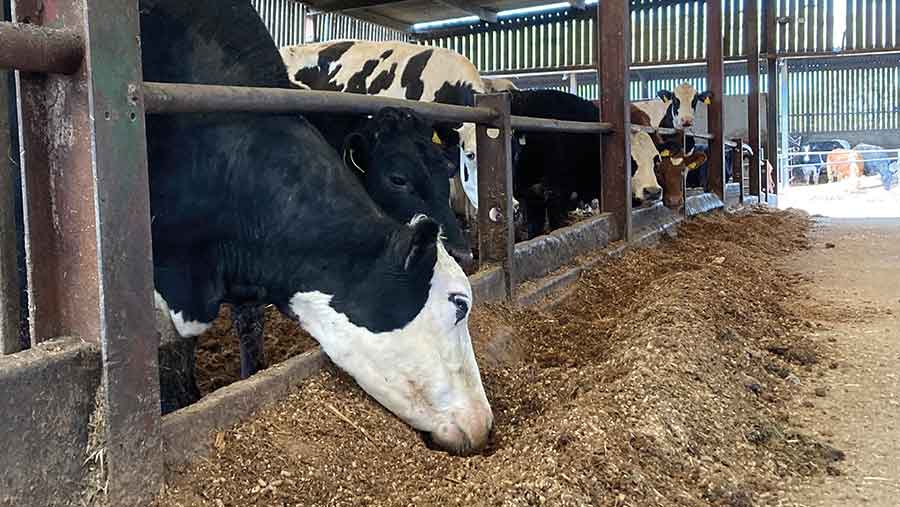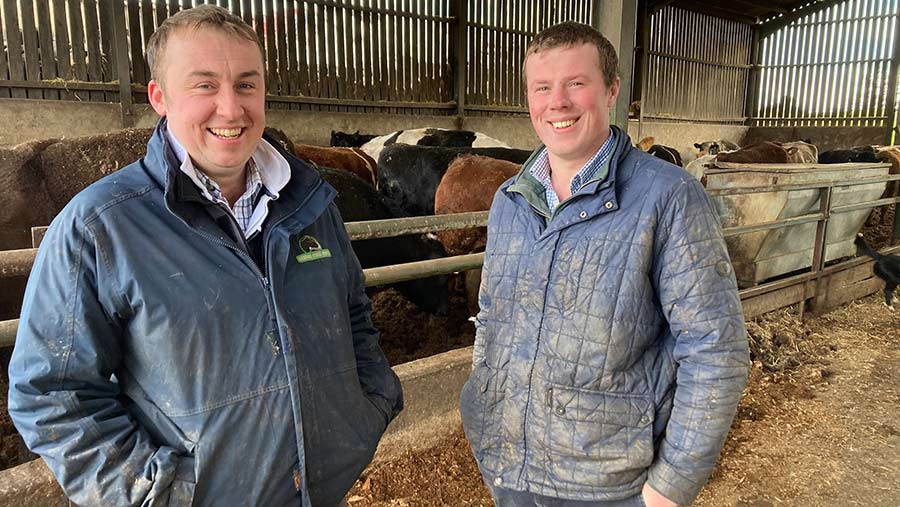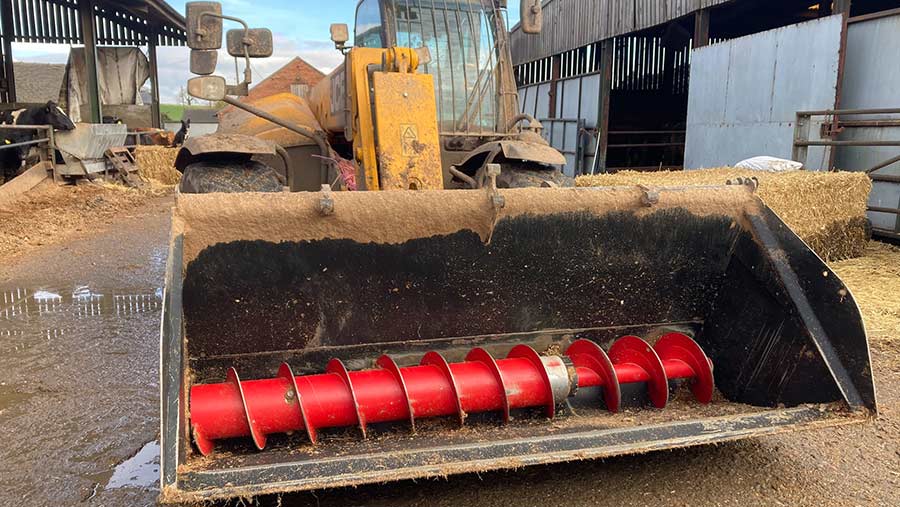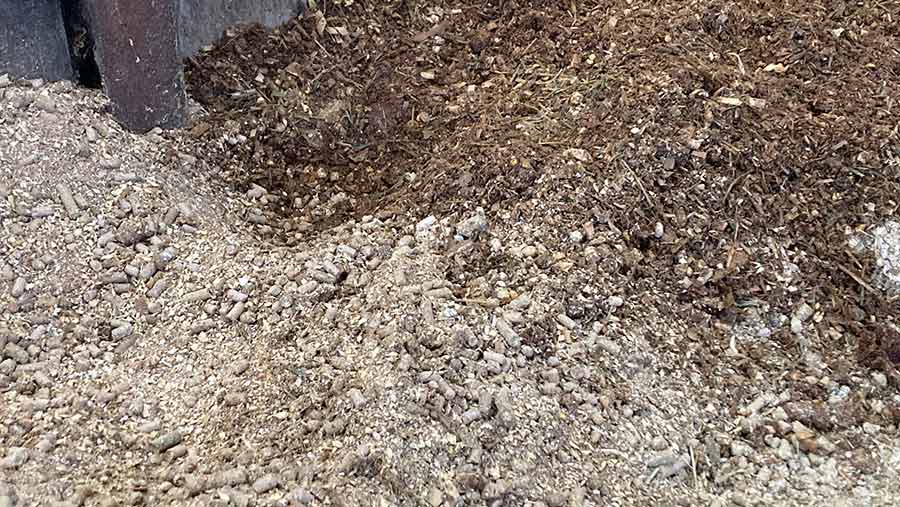How beef finisher has grown tenfold in a decade
 © MAG/Michael Priestley
© MAG/Michael Priestley Adaptability and a talent for improving growing cattle has seen a beef finishing unit expand rapidly after acquiring a second farm and embarking on a shed-building programme.
Ten years ago, the Manning family sold 250-300 cattle a year. Now they sell close to 3,000 head annually from their family farm near Audley, Stoke-on-Trent.
Brothers Richard and John have flung themselves into the family business following efforts by their parents, Mark and Jane, to grow the land base at Brook Farm (see “Expansion timeline”) to give their two children a chance of farming.
See also: How Angus-crosses beat Blues by £200 for integrated graziers

Richard and John Manning © MAG/Michael Priestley
Farm facts
ME Manning, Audley, Staffordshire
- About 3,000 cattle sold deadweight annually
- Sells 40-80 cattle a week
- Land in three main blocks within five miles
- 65ha owned and a further 65ha rented
- 17ha of maize and a similar amount of grass silage
Keen to make the business partnership work, the Manning brothers supplement income with wages earned through relief milking off-farm.
“Our business is based on cashflow and quick turnarounds,” says John. “We try to buy cattle that look like they will grow.”
Expansion
Brook Farm is a 33ha (82-acre) lowland grass unit and has been home to three generations of the family. Mark has been finishing beef his whole farming career.
Rental values are high, as the farm is in prime dairy country near the Cheshire border, says John. Stewardship grazing makes close to £500/ha and the best ground can be let for £700-£800/ha or more.
Nevertheless, Mark managed to secure a mortgage on a small farm with good grazing ground close by. Other land has been rented to allow the business to grow maize.
Cash from beef sales has been reinvested in new sheds. Designs are based on steel frames, Yorkshire boarding and concrete panel sides.
Flooring is mainly crushed stone with a concrete floor at the front (3.65m) of the feeding pad.
Expansion timeline
- 2000 Built a 30.5×12.2m shed at Brook Farm to winter and finish suckler-bred cattle as an addition to the brick farm buildings.
- 2004 Bought Firs Farm 0.7 miles away for grazing and cutting grass silage. It had one small shed, but little else. This is a “clean farm” for TB.
- 2005 A small increase in capacity was achieved at Brook Farm – which is an approved TB finishing unit – by taking cubicles out of the suckler shed to avoid the need to store slurry. This, like all the other sheds, is based on loose housing on straw.
- 2014 Another shed with an apex was added at Brook Farm, with capacity for 80-100 head of growing cattle.
- 2017 About 120-head capacity was created by erecting a 30.5×12.2m shed at Firs Farm. An 18.2×12.2m L-shaped extension added a further 70-head capacity 18 months later.
- 2020 Firs Farm was developed again with two 24.3×12.2m sheds. This took capacity to 700 head, depending on the age/size of the cattle on farm. In summer, there could be 200-250 head more at grass.
Feeding
Feeding is based on supplementing grass silage and maize silage with the best-quality, affordable energy and protein supplements.
For several years, the Mannings fed a 34% crude protein pellet (with a live yeast) and rolled barley. However, rocketing commodity prices made this uneconomical in 2021.
They adapted by developing a ration that took advantage of their proximity to local food factories and brewers. Brook Farm – which lies adjacent to the M6 – now has the following feed deliveries:
- A fortnightly delivery of 17t of traditional brewers’ grains
- 28t bread every three weeks
- 16t maize a week
- 28t Trafford Gold moist feed a week
- 36t protein blend a week.
The first diet is a forage-based transitioning ration based on one bucket of bread, one bucket of brewers’ grains, two buckets of Trafford Gold, four buckets of maize and one bucket of clamp silage.
The higher-starch portion of the diet is offered by a second mix consisting of barley, malt rootlets, wheat feed pellets, biscuit and confectionary meal, and a molasses blend from Premier Mixes, which has taken the place of rolled barley.
This is increased over time. Some cattle already on a cereal diet can eat this on arrival.
Feeds are piled in front of the grass silage clamp, where they are mixed and moved to the front of the cattle pens using a JCB Loadall fitted with an auger bucket.
A bale of straw and a bale of grass silage are offered ad-lib to every pen to help rumen health.
Five trips are done every day along the 0.7-mile route to Firs Farm with an auger bucket full of feed.

© MAG/Michael Priestley
The Loadall does 1,200 hours a year (more than three hours a day) and is traded in every three years. The auger bucket is traded in every two or so years, costing the business £1,500, but saves on a forage wagon.
Before the expansion, the farm ran a tractor, a loader and a scraper tractor for the cubicle shed. Now, it runs an 18t silage trailer, a 10.3m cattle box, a muckspreader, a straw chopper, a Loadall and two tractors.
Contractors are paid to make 17ha (42 acres) of maize silage and take two cuts of grass silage. First cut is taken on 27ha (67 acres) and is clamped, while second cut, on a further 20ha (49 acres), is baled.
A wagon and drag of straw is delivered every 10 days. Muck is exported on muck-for-straw agreements.

© MAG/Michael-Priestley
Cattle sourcing
Historically, Mark bought U-grade-type suckled calves and crossbred dairy yearlings to graze, winter and finish.
To grow and manage cashflow, the Mannings have broadened their sourcing policy, buying British Friesian feeding cows, strong Holsteins and continental suckler feeding cows, as well as youngstock and bulls from E- to P-grade.
Cows with young calves are bought to farm and separated.
“We aren’t bothered how thin or fat they are, or what breed,” explains John.
“They all have their place. You need to buy the right animal: one you can improve.”
Most cattle come from live markets across the West Midlands and into Wales and the Pennines.
Others are bought privately. Richard attends one market, John regularly visits three, and three agents buy for the business.
Cattle can be bought and sold very quickly – as soon as they meet standstill rules.
Most do 90-100 days to qualify for farm assurance, and younger cattle are fed for a year or more. The farm carries 60 cows and calves, mostly from “bonus” calvings, when barren cows are found to be in-calf.
Every animal gets a live bovine viral diarrhoea vaccine on arrival and is wormed as necessary.
Dosing rates are based on the market’s weigh crate figures. The Mannings do not weigh cattle, instead saving time by drawing cattle by eye.
Future plans
The Mannings hope to take on more rental ground to graze more cattle in summer and increase forage production.
They will also look into reducing volatility by investigating contract rearing dairy beef and the potential labour savings of buying and finishing larger batches.
